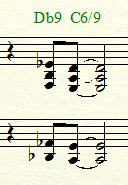.Jazz Piano Chord Voicings Program
 I would like to express my heartfelt thanks to the many recent positive comments I have been receiving from participants of this popular jazz piano chord voicings program. I often reflect on the moments of creation of ProProach and, whenever I do, I experience great feelings, as the energy that went into it was a manifestation of a desire to convey to others a simple, step-by-step procedure for others to enjoy many of the “tricks of the trade” in a fashion that was not only easy to understand but easy to implement. I’m so happy to continue to be able to report that people worldwide are enjoying its benefits.
I would like to express my heartfelt thanks to the many recent positive comments I have been receiving from participants of this popular jazz piano chord voicings program. I often reflect on the moments of creation of ProProach and, whenever I do, I experience great feelings, as the energy that went into it was a manifestation of a desire to convey to others a simple, step-by-step procedure for others to enjoy many of the “tricks of the trade” in a fashion that was not only easy to understand but easy to implement. I’m so happy to continue to be able to report that people worldwide are enjoying its benefits.
Make The Most Each Lesson
Another thing I would like to express gratitude for is the devotion to those who have subscribed to the concept of learning and digesting one lesson at a time. Yes, I do completely understand the initial inclination to want to have all the lessons at once. Due to popular request, I have made the program available this way. That said, let me just mention that people who take advantage of this chord voicings program and use it in the manner in which it was originally intended are realizing the true value of following along this way.
I have a suggestion to those who have yet to enroll in ProProach. You will gain more value by taking yourself through the program again… and again. Individuals who follow through with 25 lessons more than once always experience benefits well beyond those gained from just one time. This continues to be confirmed by actual members who do so.
To those considering enrolling in the program, I would like to offer the suggestion that you use Lesson #1 and Lesson #2 in conjunction with each other. They are very much related. Spend at least a week with these lessons and apply them to the various keys (Cmaj9, Fmaj9, Bbmaj9, Dmin9, Gmin9, Amin9, etc). The satisfaction gained by doing so is huge, not to mention the confidence that you’ll begin to enjoy.
Stay Curious When Learning Jazz Piano Chord Voicings
In addition, I would encourage you to enjoy these lessons with an attitude of curiosity. Have fun with them as a child might have fun with a set of finger paints. The many “colors” that you are capable of creating are unlimited. As you continue to experience one lesson after another, you’ll see this for yourself. Furthermore, if you decide to get involved in Pro Piano Chord Bytes , you’ll experience something rather unique, as the two programs will enhance your piano chord voicing creative skills. ProProach does include a complimentary video with each lesson. For reasons aligned with taking personal creative initiative, Pro Piano Chord Bytes does not. Enroll and implement the strategies of both programs with enthusiasm and curiosity. Your results will be nothing short of astounding.




 When you hear the same tune being played by a number of different players, it’s pretty easy to determine which of those players have a real handle on what they are doing in terms of harmony. It doesn’t take much effort to recognize when great sounding piano chords are being played.
When you hear the same tune being played by a number of different players, it’s pretty easy to determine which of those players have a real handle on what they are doing in terms of harmony. It doesn’t take much effort to recognize when great sounding piano chords are being played.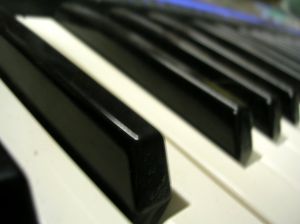
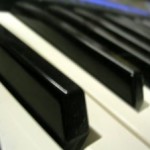 Your repertoire of jazz piano chords will undoubtedly include the exploration of quartal voicings if you are sincere in your interest in this art form. There is much to share when it comes to quartal voicings and we do acknowledge them in
Your repertoire of jazz piano chords will undoubtedly include the exploration of quartal voicings if you are sincere in your interest in this art form. There is much to share when it comes to quartal voicings and we do acknowledge them in 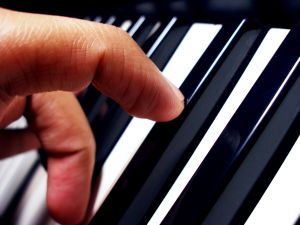
 Our focus on cocktail piano chords has included some attention on open chord voicings. As a review, let’s consider one way we can open up a chord like a Major 7th. We’ll use Fmaj7 for our example. This chord, in its most basic form (root position) is spelled like this:
Our focus on cocktail piano chords has included some attention on open chord voicings. As a review, let’s consider one way we can open up a chord like a Major 7th. We’ll use Fmaj7 for our example. This chord, in its most basic form (root position) is spelled like this: Play this new chord voicing as we have illustrated it and listen. Then compare the one preceding it by playing them both back and forth. It’s interesting how making one simple modification can change the texture of the voicing we are playing.
Play this new chord voicing as we have illustrated it and listen. Then compare the one preceding it by playing them both back and forth. It’s interesting how making one simple modification can change the texture of the voicing we are playing.
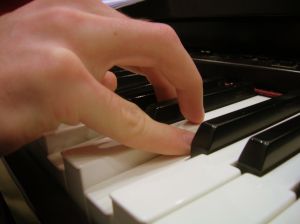
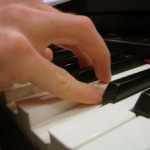 Our journey with jazz piano chords continues as we take a look at upper structure triads. There are several of these and, here, will take a look at one.
Our journey with jazz piano chords continues as we take a look at upper structure triads. There are several of these and, here, will take a look at one. The drop 3 voicing is one of those piano chords that can be endlessly explored… and well worth the time and effort, too! Adding this concept to your cocktail piano playing will most surely add more interest to those standard songs.
The drop 3 voicing is one of those piano chords that can be endlessly explored… and well worth the time and effort, too! Adding this concept to your cocktail piano playing will most surely add more interest to those standard songs. Okay, let’s turn this into a drop 3. Again, we will take that 3rd note from the top (in this case, the Bb) and move it one octave below:
Okay, let’s turn this into a drop 3. Again, we will take that 3rd note from the top (in this case, the Bb) and move it one octave below: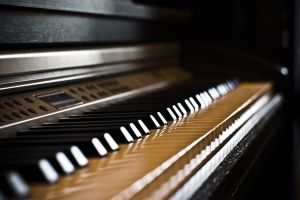 During our last lesson that focused on jazz piano chords, we took a look at a very popular way to voice that II-V chord progression among the pros. It’s interesting to note that this II-V chord progression is the most common chord progression in all of jazz and pop harmony. Well, let’s take a look at an extension of this progression…
During our last lesson that focused on jazz piano chords, we took a look at a very popular way to voice that II-V chord progression among the pros. It’s interesting to note that this II-V chord progression is the most common chord progression in all of jazz and pop harmony. Well, let’s take a look at an extension of this progression…

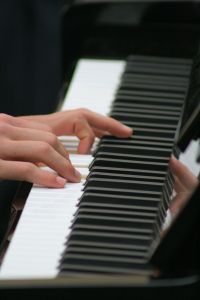 As our fun with jazz piano chords continues, here we will make reference to a previous lesson that focused on turning a minor 7th chord into a minor 9th chord. Specifically, we will use the same Dmin9 chord voicing for our purpose.
As our fun with jazz piano chords continues, here we will make reference to a previous lesson that focused on turning a minor 7th chord into a minor 9th chord. Specifically, we will use the same Dmin9 chord voicing for our purpose.  These are two of the most popularly played jazz piano chords of all time. Again, it’s that one little “switch” that turns the Dmin9 into a G13 chord.
These are two of the most popularly played jazz piano chords of all time. Again, it’s that one little “switch” that turns the Dmin9 into a G13 chord.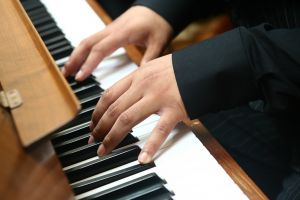 Let’s take a look at a couple of jazz piano chords that, when played one after the other, make for one of the most popular endings of all time. We will relate this to the key of C Major for our illustration. Of course, as always, you are highly encouraged to transpose what you learn to other keys.
Let’s take a look at a couple of jazz piano chords that, when played one after the other, make for one of the most popular endings of all time. We will relate this to the key of C Major for our illustration. Of course, as always, you are highly encouraged to transpose what you learn to other keys.